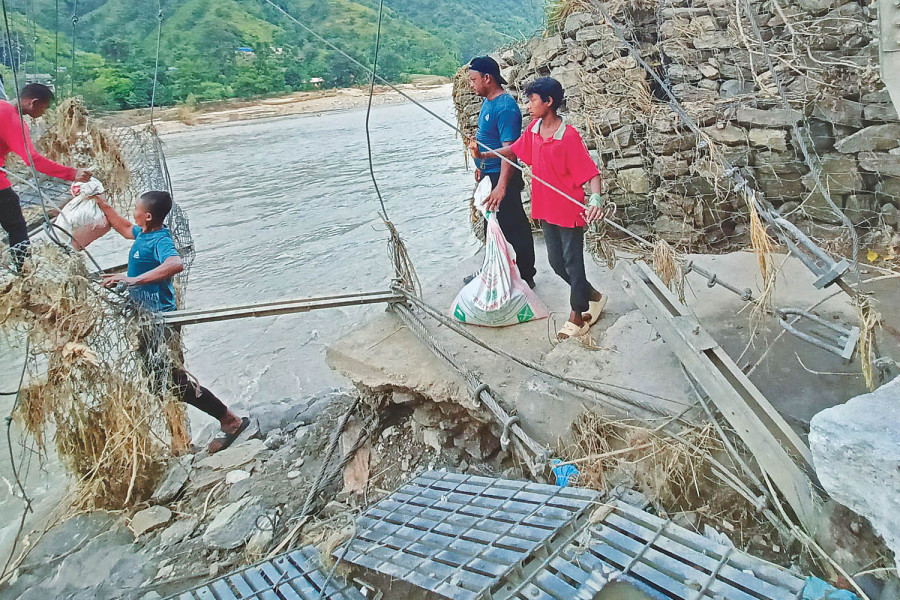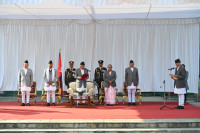National
Disaster crisis zones declared. Now what?
Officials say the declaration means that rehabilitation, recovery and reconstruction works will be expedited based on local priorities.
Purushottam Poudel
The government has declared dozens of local units in 14 districts that were the hardest hit by last week’s monsoon rains as ‘disaster crisis zones’ with the objectives of expediting rehabilitation, recovery and reconstruction efforts there.
A Cabinet meeting on Friday named several local units as the most affected on the recommendation by the National Disaster Risk Reduction and Management Authority (NDRRMA) of the Ministry of Home Affairs.
Now, the question is: will the designation of the areas as crisis zones really help expedite the work and how will work here be done differently to other places?
Government officials said they will take a victim-oriented approach.
“With the declaration of disaster crisis zones, the government will focus on relief distribution with a special focus on the people of the local units in the 14 districts,” Kali Prasad Parajuli, the federal affairs and general administration ministry spokesperson, told the Post.
Every place has its unique problems: in some areas the agricultural sector has been the most hampered and the government will pay more attention to addressing that problem, whereas in the places where physical infrastructure is damaged, the authorities will focus on addressing the particular issue with urgency, Parajuli said. According to him, they will prioritise work based on local needs.
“Declaring disaster crisis zones will give authorities extra leverage, allowing them to fast-track the procurement process and many other things to immediately address local problems,” Parajuli said.
Though the Cabinet has declared the disaster zones, the names of the districts and the local units will be clear only after the decision gets published in the National Gazette with details, officials said.
Although 26 districts are affected, the number of declared crisis areas is said to be only around a dozen. Officials say their exact number will be known only when a related notice is published in the national gazette.
Under the Disaster Risk Reduction and Management Act 2017, the government can announce a disaster-crisis area to respond to a calamity by specifying its boundaries and a time limit.
In crisis-designated areas, the government can make decisions such as prohibiting any operation that may adversely affect rescue work, employing government or non-government sector employees, and using government, non-government, or private movable and immovable property as needed for disaster rescue work, as per the Act.
If necessary, the government can get hold of the vehicles of any agency or person available in the designated areas and use them for relief and rescue, the Act says.
Phidim Municipality, one of the areas in eastern Nepal most affected by the continuous rain on September 27 and 28, has been named a disaster crisis zone. Parts of the Mechi Highway and the Phidim-Phalot road swept away by the floods have yet to be restored.
Mayor Mitra Prasad Kafle of Phidim Municipality welcomes the government’s decision to label the municipality a disaster crisis zone.
“Due to floods and landslides, our municipality alone witnessed seven deaths, whereas 75 houses were fully damaged,” Kafle told the Post. “When the floods hit the Mechi Highway and the Phidim-Phalot road, the vehicular movement here was severely disrupted.”
Kafle said the local government distributed relief materials but it was insufficient.
Arjun Jung Thapa, former director general of the department of roads, said that after disaster crisis zones are declared, the government will be accountable for rehabilitating the displaced people there.
These places will get priority in budget allocation, and preference will be given to building damaged physical infrastructure, Thapa told the Post. “Relief, rescue, and rehabilitation are the three areas the government must prioritise after identifying disaster crisis zones.”
However, Thapa said the declaration alone won’t suffice and the government and its agencies must also internalise the need to expedite work in order to ease people’s suffering.




 17.12°C Kathmandu
17.12°C Kathmandu















